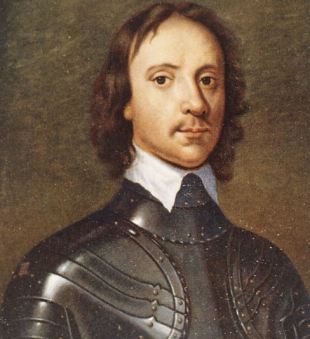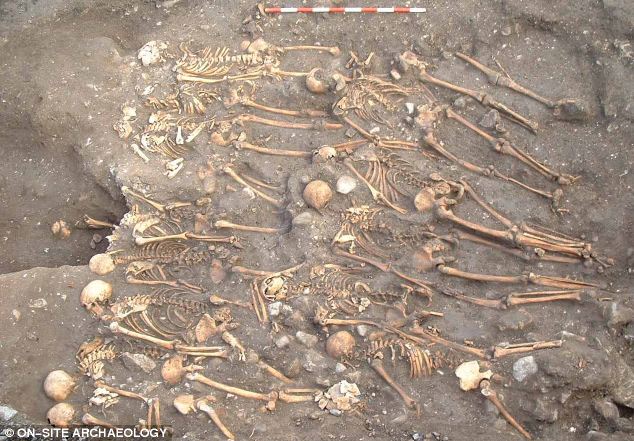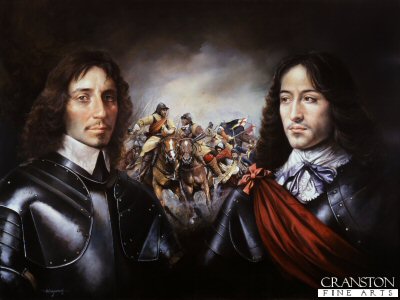Archaeologists have discovered the skeletons of over 100 Roundheads from the English Civil War.
The skeletons, buried in mass graves, of 113 of Oliver Cromwell's Parliamentarian soldiers were discovered in York.
The location, in the Fishergate area of the city, is the site of the "lost" 11th Century church of All Saints. Routine excavations in 2007 to look for the church instead uncovered the mass graves from the English Civil War era.
Even back in 1644 when the graves were dug, only the shell of the church remained. The graves vary in size, with the smallest containing four skeletons and the largest 18.
Despite being the skeletons of soldiers, it is thought they were not killed in battle but by infectious disease during the siege of the city.
During the English Civil War, York was a Royalist-supporting city and was besieged by a Parliamentary force of 30,000 between April and July 1644.
On 2nd July 1644, the Parliamentarians (Roundheads) and Royalists (Cavaliers) clashed just outside the city during the Battle of Marston Moor, the largest single battle of the English Civil War. The siege of York ended soon after.
The battle was a resounding Parliamentarian victory. 4000 of Charles I's Cavaliers were killed compared to just 300 Roundheads.
In 1645, Cromwell's Parliamentarian forces, which had previously been a collection of regional fighting groups, unified to form the New Model Army.
The leader of the Parliamentarians - or Roundheads as they were known because of the soldiers' close-cropped hair - Oliver Cromwell ensured that the members of the New Model Army were Puritans like himself. The Roundheads called their war against King Charles I the "Good Old Cause."
The republican army was the first British army to wear the famous red coat uniform, and it helped the Parliamentarians to become victorious in the war, making England a Puritan republic from 1649 to 1660, ruled first by the Rump Parliament and the Council of State then, between 1653 and 1658, by Oliver Cromwell and, between 1658 and 1659, by Cromwell's son Richard. During the republic, theatres, football, other forms of entertainment and even Christmas were banned by England's Puritan leaders.
However, the monarchy was restored in 1660 with the coming to the Throne of Charles II. During his reign he kept a small standing army formed from elements of both the Royalist Army and the New Model Army, which was eventually to become the English Army. When England (including Wales) unified with Scotland in 1707 the English Army then unified with the Scottish Army to form the British Army.
Oliver's lost army: Buried side by side, the Roundheads who fell victim to a terrible siege
By Chris Brooke
18th August 2010
Daily Mail
They were crammed together and buried side by side, stripped of all clothing and personal possessions.
Force of circumstance determined this most impersonal and undignified resting place.
For the men buried in mass graves at a ruined York church were the soldiers of Oliver Cromwell's Parliamentary army.

Skeleton army: The remains found in York, one of 10 mass graves containing Roundhead soldiers
The Roundheads were not killed in combat but probably by infectious disease during the gruelling English Civil War siege of the city.

Leader: Oliver Cromwell led the Roundhead cavalry and then England
Their comrades went on to defeat King Charles I's Cavaliers at the Battle of Marston Moor in 1644 and turn the tide of the war.
But history forgot the more than 100 souls who probably never made it to the battleground.
Now, more than 350 years later, archaeologists have unearthed the graves and their skeletons to reveal the story of Cromwell's forgotten soldiers.
Routine excavations in 2007 at the site of a medieval church, south of York's historic city walls, led to the uncovering of ten mass graves.
Archaeologists knew from previous discoveries that the 'lost' 11th century church of All Saints in Fishergate had once been there.
However, these newlydiscovered graves took archaeologists forward 600 years to a time when the country was split in two by a bloody civil war.
The position of the graves showed they were dug at a time when only the shell of the abandoned church remained. They varied in size, with the smallest containing four skeletons and the largest 18.

Delicate work: An archaeologist examines one of the 350-year-old bodies

No ceremony: The bodies were evidently buried with some haste
The skeletons were arranged neatly in parallel rows, mostly laid on their side or face down in the dirt, and were packed together like sardines in a can. Larger graves had a second row where the heads of one row overlapped the feet of another.
No buckles, buttons or jewellery were found, indicating they were probably buried naked. In total there were 113 skeletons.
It was not possible to establish the sex of them all, but 87 were male, most between the ages of 35 and 49.

The Battle of Marston Moor took place just outside York on 2nd July 1644. The largest single battle of the English Civil War, it was won by Oliver Cromwell's Roundheads.
Details of the find are revealed in Current Archaeology magazine in a report by experts Lauren McIntyre and Graham Bruce.
Analysis of the skeletal remains indicated they were not wounded and did not die in battle. But most had conditions, such as spinal joint disease, caused by excessive physical labour.

A Roundhead
'The skeletons are likely to represent a military group who all died within a short period,' said the authors.
'Given the probable 17th century date, it is likely that they relate to the Civil War.'
York was a Royalist stronghold and was besieged by a Parliamentary force of 30,000 between April and July 1644.
The siege ended soon after both armies clashed in fields outside York at Marston Moor - the largest single battle of the Civil War.

Portrait of Sir Thomas Fairfax and Prince Rupert of the Rhine. Sir Thomas Fairfax (1612-71) Captain general of the Parliamentary New Model Army and his opponent Prince Rupert of the Rhine (1619-82) nephew of King Charles I and General of Royalist Horse. Centre section of the painting depicts cavalry engagement during the 1644 Battle of Marston Moor.
Evidence suggests that the 113 bodies could well have been Cromwell's soldiers who died from disease while laying siege to the city.
Although the Royalist army was well-provided for behind the city walls, the besieging Parliamentary forces suffered severe deprivation, making them susceptible to illness and diseases such as dysentery and typhoid.
The skeletons are being kept for further study at the University of Sheffield's archaeology department.
PSALMS BEFORE BATTLE

Cromwell's Parliamentary army in 1644 was a loose collection of regional fighting groups, unified the following year as the New Model Army.
The intention was to enforce strict discipline in return for regular pay of eight pence per day for the infantry and two shillings for the cavalry.
It was the first British army to wear the famous red coat uniform. The infantry had muskets or pikes, the troopers carried a sword and two pistols.
Derided by Royalists as the 'new noddle' army, it became an effective force under the command of Sir Thomas Fairfax, with Cromwell initially in charge of the cavalry.
Officers were appointed on merit rather than status. As Cromwell wrote to a friend in 1643: 'I had rather have a plain russet-coated captain that knows what he fights for, and loves what he knows, than that which you call a gentleman and is nothing else.' One colonel was a shoemaker.
Cromwell preferred soldiers who were devoted Puritans like himself and sang psalms before battle. Their close-cropped hair led to the term Roundheads.
dailymail.co.uk
The skeletons, buried in mass graves, of 113 of Oliver Cromwell's Parliamentarian soldiers were discovered in York.
The location, in the Fishergate area of the city, is the site of the "lost" 11th Century church of All Saints. Routine excavations in 2007 to look for the church instead uncovered the mass graves from the English Civil War era.
Even back in 1644 when the graves were dug, only the shell of the church remained. The graves vary in size, with the smallest containing four skeletons and the largest 18.
Despite being the skeletons of soldiers, it is thought they were not killed in battle but by infectious disease during the siege of the city.
During the English Civil War, York was a Royalist-supporting city and was besieged by a Parliamentary force of 30,000 between April and July 1644.
On 2nd July 1644, the Parliamentarians (Roundheads) and Royalists (Cavaliers) clashed just outside the city during the Battle of Marston Moor, the largest single battle of the English Civil War. The siege of York ended soon after.
The battle was a resounding Parliamentarian victory. 4000 of Charles I's Cavaliers were killed compared to just 300 Roundheads.
In 1645, Cromwell's Parliamentarian forces, which had previously been a collection of regional fighting groups, unified to form the New Model Army.
The leader of the Parliamentarians - or Roundheads as they were known because of the soldiers' close-cropped hair - Oliver Cromwell ensured that the members of the New Model Army were Puritans like himself. The Roundheads called their war against King Charles I the "Good Old Cause."
The republican army was the first British army to wear the famous red coat uniform, and it helped the Parliamentarians to become victorious in the war, making England a Puritan republic from 1649 to 1660, ruled first by the Rump Parliament and the Council of State then, between 1653 and 1658, by Oliver Cromwell and, between 1658 and 1659, by Cromwell's son Richard. During the republic, theatres, football, other forms of entertainment and even Christmas were banned by England's Puritan leaders.
However, the monarchy was restored in 1660 with the coming to the Throne of Charles II. During his reign he kept a small standing army formed from elements of both the Royalist Army and the New Model Army, which was eventually to become the English Army. When England (including Wales) unified with Scotland in 1707 the English Army then unified with the Scottish Army to form the British Army.
Oliver's lost army: Buried side by side, the Roundheads who fell victim to a terrible siege
By Chris Brooke
18th August 2010
Daily Mail
They were crammed together and buried side by side, stripped of all clothing and personal possessions.
Force of circumstance determined this most impersonal and undignified resting place.
For the men buried in mass graves at a ruined York church were the soldiers of Oliver Cromwell's Parliamentary army.

Skeleton army: The remains found in York, one of 10 mass graves containing Roundhead soldiers
The Roundheads were not killed in combat but probably by infectious disease during the gruelling English Civil War siege of the city.

Leader: Oliver Cromwell led the Roundhead cavalry and then England
Their comrades went on to defeat King Charles I's Cavaliers at the Battle of Marston Moor in 1644 and turn the tide of the war.
But history forgot the more than 100 souls who probably never made it to the battleground.
Now, more than 350 years later, archaeologists have unearthed the graves and their skeletons to reveal the story of Cromwell's forgotten soldiers.
Routine excavations in 2007 at the site of a medieval church, south of York's historic city walls, led to the uncovering of ten mass graves.
Archaeologists knew from previous discoveries that the 'lost' 11th century church of All Saints in Fishergate had once been there.
However, these newlydiscovered graves took archaeologists forward 600 years to a time when the country was split in two by a bloody civil war.
The position of the graves showed they were dug at a time when only the shell of the abandoned church remained. They varied in size, with the smallest containing four skeletons and the largest 18.

Delicate work: An archaeologist examines one of the 350-year-old bodies

No ceremony: The bodies were evidently buried with some haste
The skeletons were arranged neatly in parallel rows, mostly laid on their side or face down in the dirt, and were packed together like sardines in a can. Larger graves had a second row where the heads of one row overlapped the feet of another.
No buckles, buttons or jewellery were found, indicating they were probably buried naked. In total there were 113 skeletons.
It was not possible to establish the sex of them all, but 87 were male, most between the ages of 35 and 49.

The Battle of Marston Moor took place just outside York on 2nd July 1644. The largest single battle of the English Civil War, it was won by Oliver Cromwell's Roundheads.
Details of the find are revealed in Current Archaeology magazine in a report by experts Lauren McIntyre and Graham Bruce.
Analysis of the skeletal remains indicated they were not wounded and did not die in battle. But most had conditions, such as spinal joint disease, caused by excessive physical labour.
A Roundhead
'The skeletons are likely to represent a military group who all died within a short period,' said the authors.
'Given the probable 17th century date, it is likely that they relate to the Civil War.'
York was a Royalist stronghold and was besieged by a Parliamentary force of 30,000 between April and July 1644.
The siege ended soon after both armies clashed in fields outside York at Marston Moor - the largest single battle of the Civil War.

Portrait of Sir Thomas Fairfax and Prince Rupert of the Rhine. Sir Thomas Fairfax (1612-71) Captain general of the Parliamentary New Model Army and his opponent Prince Rupert of the Rhine (1619-82) nephew of King Charles I and General of Royalist Horse. Centre section of the painting depicts cavalry engagement during the 1644 Battle of Marston Moor.
Evidence suggests that the 113 bodies could well have been Cromwell's soldiers who died from disease while laying siege to the city.
Although the Royalist army was well-provided for behind the city walls, the besieging Parliamentary forces suffered severe deprivation, making them susceptible to illness and diseases such as dysentery and typhoid.
The skeletons are being kept for further study at the University of Sheffield's archaeology department.
PSALMS BEFORE BATTLE

Cromwell's Parliamentary army in 1644 was a loose collection of regional fighting groups, unified the following year as the New Model Army.
The intention was to enforce strict discipline in return for regular pay of eight pence per day for the infantry and two shillings for the cavalry.
It was the first British army to wear the famous red coat uniform. The infantry had muskets or pikes, the troopers carried a sword and two pistols.
Derided by Royalists as the 'new noddle' army, it became an effective force under the command of Sir Thomas Fairfax, with Cromwell initially in charge of the cavalry.
Officers were appointed on merit rather than status. As Cromwell wrote to a friend in 1643: 'I had rather have a plain russet-coated captain that knows what he fights for, and loves what he knows, than that which you call a gentleman and is nothing else.' One colonel was a shoemaker.
Cromwell preferred soldiers who were devoted Puritans like himself and sang psalms before battle. Their close-cropped hair led to the term Roundheads.
dailymail.co.uk
Last edited: